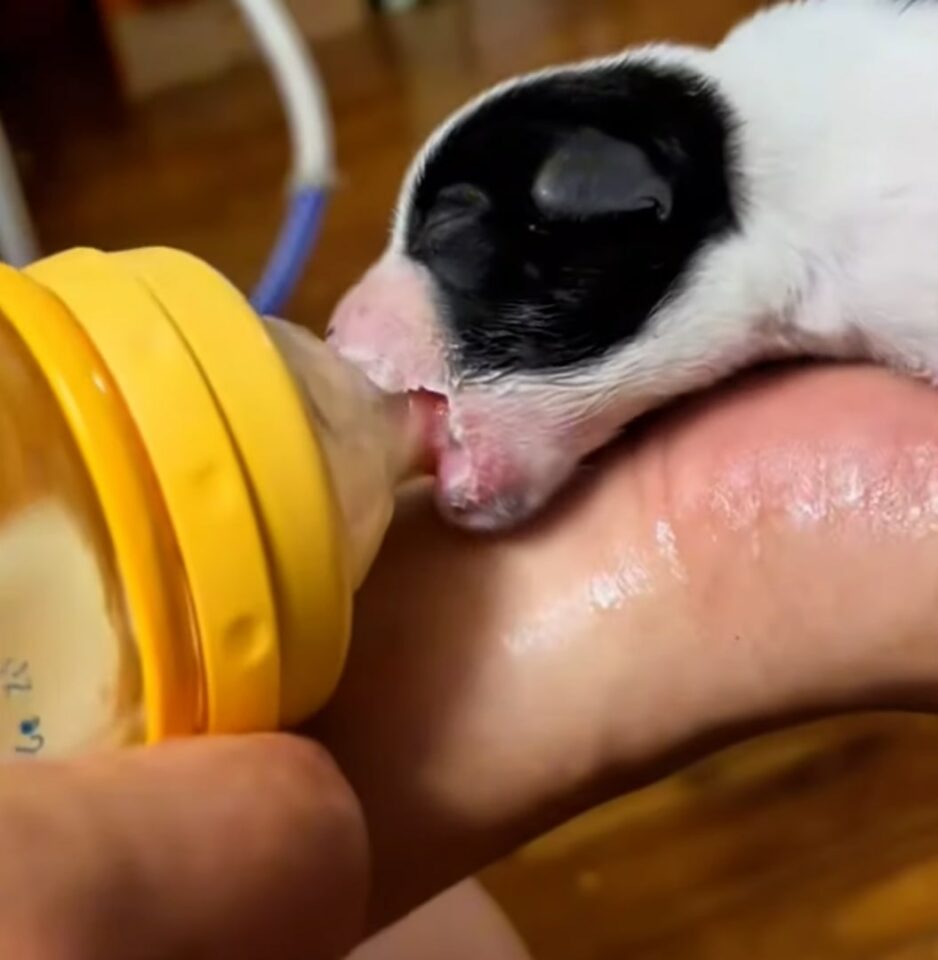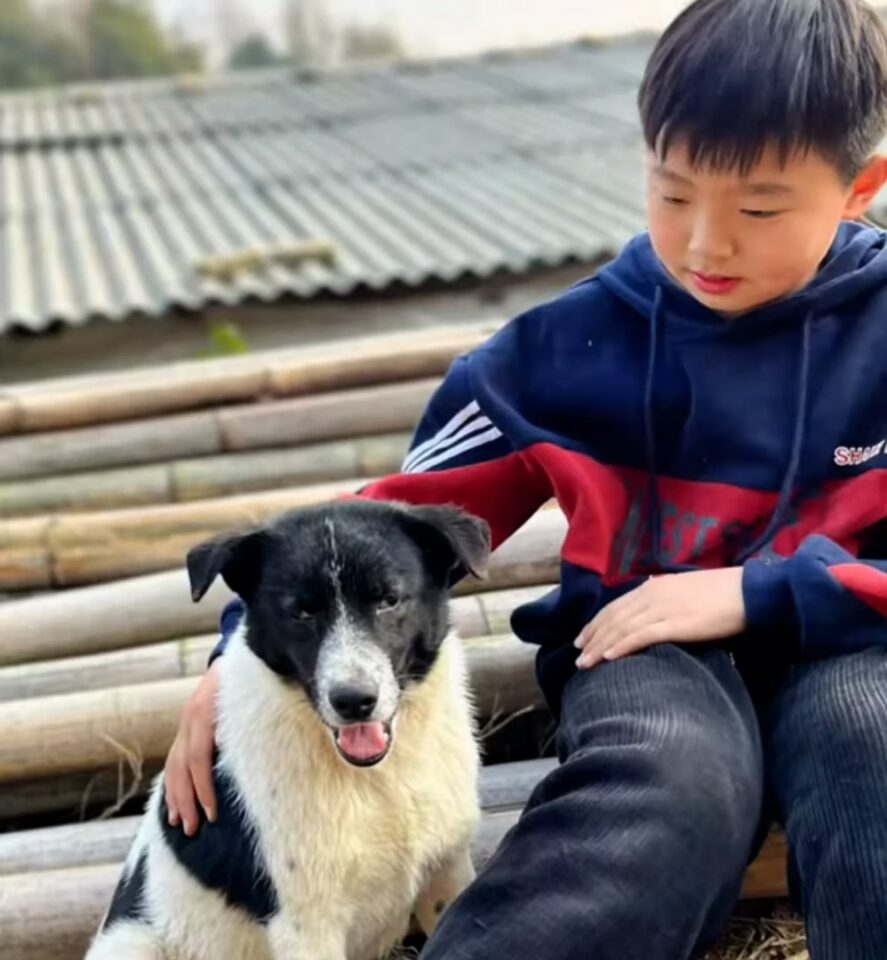Imagine taking a trip with your family and running into a teeny-tiny helpless pup on the way.
That’s exactly what happened to one family when they accidentally looked at the nearby bushes. Right there, on a pile of dry leaves, was a fur baby. Not older than one week, he was completely motionless.
The family was even more shocked to realize that he was all alone without his mother or siblings. Only moments away from facing the inevitable, the puppy craved someone to take care of him, and now he had a whole group!
He Craved Help

Even though it wasn’t exactly the visit to their hometown like they had planned, the family was really excited to help the poor pup in need.
They knew how badly he needed care, so they immediately scooped him up and took him to their car. On the way home, they stopped at a nearby store to buy all the necessary things for their newest family member.

First things first, they fed the pup the formula. And, boi was that a great feeling!
The fact that this poor baby finally had its first meal after who knows how long was just precious. In about ten minutes, he drank the whole bottle, which indicated how hungry he must’ve been.
Then, he took a comfortable, well-deserved nap!
The family continued the process for the next couple of weeks. They fed the baby boi around the clock and played the role of his mom. Given that he was only a week old when he was found, he needed someone to be there for him 24/7.

They set a nice, cozy blankie inside a cardboard box for the puppy to sleep on. As a tiny welcoming gesture, they also added a plush toy for him to feel safer.
Within only a few days, he already felt so much better… and stronger, too!
Doing Zoomies Is His Secret Power

Who would’ve said that such a tiny pup would soon grow into the quirkiest family member?
That’s right! Ladies and gents, we have a real entertainer here. As it turns out, he’s naturally an active boi who just loves doing zoomies all day long!

He loves to play with his plushies, too! Sometimes, for reasons his family can’t explain, he even gets into a fight with the toys! And yet, he does it so funnily that his hoomans can’t resist him.
He’s just a natural charmer who loves everything about his new life. The fact that he grew up into such an enthusiastic boi is precious to his family. But, at heart, everybody still sees him as a little baby.
The Big Boi Is Still A Baby At Heart

Today, the pup is a fully-grown dog who looks nothing like his old self. Far away from that pile of leaves, he now has a whole new life.
Recently, he and his family visited their hometown again, only this time, they had their furry companion right there with them.
From this new perspective, the saying: “Life works in mysterious ways” definitely rings undeniably true. Once an abandoned boi fighting for life, the pup is now a big boy, standing proudly in the very same spot, now with his story completely rewritten.
If you’ve ever bitten into a hot dog at a ball game or a backyard barbecue, you might have wondered about the journey this iconic snack took before landing on your plate. The process of crafting a hot dog is a blend of tradition, precision, and a touch of culinary magic. From the sizzle of the grill to the snap of the casing, each step plays a crucial role in creating that beloved hot dog experience.
As you peel back the layers of how hot dogs are made, you’ll discover a tale of craftsmanship and attention to detail that goes into each delicious bite. The artistry behind hot dog production is a fascinating blend of science and flavor, resulting in a treat that has stood the test of time as a classic favorite. So, next time you enjoy a hot dog, remember the craftsmanship that goes into this beloved comfort food.
Hot Dogs: A Delicious Insight into their Making Process
Ever wondered how those mouth-watering hot dogs are made? Let’s break it down for you:
1. Meat Selection:
Starts with selecting high-quality meats like beef, pork, chicken, or a blend thereof for that perfect flavor combination.
2. Grinding:
The meats are ground to achieve the desired consistency, ensuring a juicy and tender bite every time.
3. Seasoning:
Special seasonings and spices are added to enhance the taste profile, giving hot dogs their signature flavor.
4. Emulsification:
The meat mixture goes through emulsification to create a smooth texture, making it ideal for shaping into those familiar hot dog forms.
5. Casing:
The emulsified meat is then filled into casings that determine the size and shape of the hot dogs.
6. Cooking:
Hot dogs can be cooked by steaming, boiling, or even grilling, depending on the desired texture and flavor.
7. Cooling and Packaging:
Once cooked, the hot dogs are cooled, packaged, and ready to be enjoyed.
History of Hot Dogs
Hot dogs have a fascinating history that dates back to the late 19th century. Here’s how this beloved snack came to be:
1. Origins in Europe
Hot dogs trace their origins to Germany and Austria, where sausages were a popular food item. German immigrants brought their sausage-making traditions to the United States in the 1800s, laying the foundation for the American hot dog.
2. The Birth of the Hot Dog
The term “hot dog” is believed to have originated in the US in the early 20th century. Legend has it that a cartoonist coined the term at a baseball game in New York City when he couldn’t spell “dachshund sausage.” The name stuck, and the hot dog as we know it was born.
3. Evolution and Popularity
Hot dogs quickly gained popularity in the US, becoming a staple at ballparks, backyard barbecues, and street food vendors. Over time, various regional styles of hot dogs emerged, each with its unique twist on toppings and preparations.
4. Iconic American Food
Today, hot dogs are an iconic American food, loved for their simplicity, portability, and delicious taste. They have become a symbol of American culinary culture and are enjoyed by people of all ages across the country.
The history of hot dogs is a testament to the blend of cultural influences and culinary creativity that defines American cuisine. Next time you bite into a hot dog, remember the rich history behind this classic snack.
Ingredients of Hot Dogs
When it comes to hot dogs, the ingredients play a crucial role in shaping that classic taste. Let’s take a closer look at the key components that go into making this beloved snack:
- Meat: The primary ingredient in hot dogs is usually a mixture of beef and pork. This blend gives hot dogs their distinctive flavor and texture.
- Seasonings: To enhance the taste, various seasonings and spices are added. Common seasonings include salt, pepper, garlic, and paprika, among others.
- Binding Agents: Ingredients like corn syrup, dextrose, or maltodextrin are used as binding agents to hold the mixture together and give hot dogs their characteristic shape.
- Fillers: Fillers such as breadcrumbs or flour are added to provide structure to the hot dog and absorb excess moisture during cooking.
- Curing Agents: Sodium nitrate or nitrite is used as a curing agent to preserve the meat, prevent bacterial growth, and give hot dogs their pink color.
- Casings: Natural or synthetic casings are used to encase the hot dog mixture. Natural casings are often made from the intestines of animals.
- Water: Water is added to the mixture to ensure that the hot dog maintains its moisture content during cooking.
Hot Dog Processing
During the manufacturing process, hot dogs undergo several essential steps:
- Blending Ingredients
The first step in making hot dogs involves blending a mix of meats, typically beef and pork. This blend gives hot dogs their distinctive flavor and texture. - Adding Seasonings
After blending the meats, seasonings such as salt and garlic are added to enhance the taste of the hot dogs. - Incorporating Binding Agents
Binding agents like corn syrup or starch are included in the mix to hold the ingredients together and maintain the shape of the hot dogs. - Including Fillers
Fillers such as breadcrumbs or soy protein may be added to improve the texture and consistency of the hot dogs. - Applying Curing Agents
Curing agents, like nitrates or nitrites, are used to preserve the hot dogs and prevent bacterial growth. - Using Casings
The blended mixture is then stuffed into casings, typically made from natural or synthetic materials, to give hot dogs their cylindrical shape. - Maintaining Moisture Content
Water is added to the mixture to help maintain moisture levels during cooking, ensuring the hot dogs remain juicy and flavorful.
By following these steps, manufacturers create the beloved hot dogs enjoyed by many around the world.
Cooking and Packaging
Hot dogs are typically cooked by either boiling, grilling, or steaming. Boiling in water is a common method that ensures even cooking throughout the hot dog. Grilling hot dogs over an open flame adds a smoky flavor and those delicious grill marks. Steaming is another popular way to cook hot dogs, especially in food stands and baseball stadiums.
Once cooked, hot dogs are quickly cooled down. This cooling process helps in slicing and packaging the hot dogs efficiently. The hot dogs are then packaged, either individually or in packs, ready for distribution to grocery stores, restaurants, or other food outlets.
Packaging of hot dogs is done meticulously to maintain their freshness and quality. They are often vacuum-sealed to preserve flavor and prevent spoilage. Labels indicating the type of hot dog, expiration date, and ingredients are affixed to the packaging, ensuring consumers have all the necessary information before enjoying their hot dogs.
The cooking and packaging stage is crucial in ensuring that hot dogs reach consumers in perfect condition, ready to be enjoyed in various ways from classic hot dog buns with mustard and ketchup to gourmet toppings and creative recipes.
Conclusion
That’s the journey of hot dogs from their European roots to becoming an American favorite. The blend of meats, seasonings, and cooking methods all play a part in creating the iconic hot dog. Understanding the craftsmanship and cultural influences behind hot dog making adds a flavorful layer to your next bite. Enjoy your hot dog with the knowledge of the artistry, science, and care that go into each delicious bite.
Frequently Asked Questions
Where did hot dogs originate from?
Hot dogs have roots in Germany and Austria before becoming a popular American food.
How did the term “hot dog” come about?
The term “hot dog” is believed to have originated in the US, reflecting its place in American culinary culture.
What are the key ingredients in making hot dogs?
Hot dogs are made by blending beef and pork, adding seasonings like salt and garlic, binding agents, fillers for texture, and curing agents for preservation.
What cooking methods are used for hot dogs?
Hot dogs can be cooked by boiling, grilling, or steaming to achieve the desired taste and texture.
How are hot dogs packaged for sale?
Hot dogs are carefully packaged after cooking to maintain freshness, with labels showing type, expiration date, and ingredients for consumer information.
[no_toc]

Hey there, I’m Janet Brooks, a dog-loving student from California. I’m all about helping pups in need, especially those without homes. Me and my awesome friends work together to give shelter and love to stray dogs. Oh, and I also write blogs about dogs to share helpful info.